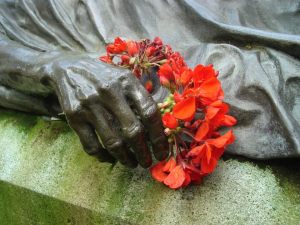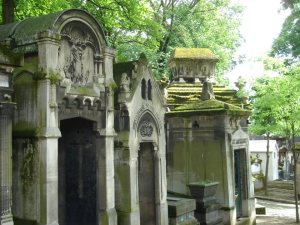Check out this submission to the Culture Shock writing contest, about a U of M student’s unique trip to a Parisian graveyard. By Maureen Vance.



“Père Lachaise’s Park”
Of all the ways to spend my weekend vacation in Paris, I wondered why I’d put the Père Lachaise Cemetery on my short list of must-sees. Maybe it was the way it merged Paris’ art, music, and literary histories, or perhaps it was just an excuse to see more than the first four arrondissements of the city. After the morning’s whirlwind bus tour I’d seen Notre Dame, the Eiffel Tower, the Arc de Triomphe, and the Rue de Rivoli half blurred through a rain-spattered window.
By late afternoon, the mid-June shower had settled into a mild drizzle, through which I walked the odd mile and a half to Paris’ most famous graveyard and passed up a legion of cafés, shops, and patisseries on the way. A month, even a year in Paris wouldn’t have been enough to see everything the city had to offer, so I’d trained my eye to photograph anything that looked even remotely noteworthy. When I first went to Père Lachaise, it was in the clinical frame of a camera lens that snapped photographs as automatically as a Mars rover collecting data for examination at the NASA lab.
My plan had been very simple: find as many famous graves as I could before the place closed for the evening, and head back to the hotel to prepare tomorrow’s itinerary. Once I’d walked past the cemetery gate, I knew I might as well forget about the map I’d sketched into my notebook; it would be a miracle if I found even the people whose graves I cared about visiting in the sea of marble. Peter Abelard and Heloise were easy because they lay under a baldachin the size of a garden shed, and Rossini was near the entrance, but locating the other names on my list would require a tiptoe through the tombstones.
The cemetery was a labyrinthine mess entirely counterproductive to the bucket list of a proactive tourist. The winding, singsong routes that stream from the entrance were the avenues of men who’d been abandoned by history, while the narrow arteries and side-roads housed enormous names that lit sparks in men’s esteem. I made the mistake of cutting through the tombs to find these big names and got lost in a tangle of post-mortem real estate. Everywhere I turned I saw small house-like graves the size of old telephone booths. With a harried glance at my watch, I promised myself I’d at least find Oscar Wilde. If I met anyone else along the way I’d simply welcome the surprise.
My head started to ache from trying to distinguish the graves and their owners, reading and rereading names that to me were no more than an arrangement of letters. Some of the tomb doors had fallen in, and I peered past their entryways with hesitance. I don’t know what I was expecting to see—maybe a skeleton standing inside with his hand raised to wave—but the tombs were empty except for an ironic bench in the back wall. How strange that the wealthy buried their relatives in hollow playhouses of stone. And for what? For all the departed celebrities laid to rest in Père Lachaise, how many nobodies were nestled between them who were now remarkable only for their tombs?
Even covered in mold, with their stained-glass windows fractured or sculptures half-consumed in vines, the graves were impressive. On top of a bier was a statue of a withered man who lay on his back as though taking his last gasp. Someone had set a red bunch of flowers in his hand. Another sarcophagus had an open book carved on its lid as testament to its owner’s love for literature. Some graves were shaped like obelisks; others were domed and flanked with majestic winged women whose stone togas rippled in the immobile wind. As I wove through the tombs, patches of sunlight filtered through the canopy of trees and hit the path in mottled flecks.
In the end I did find Oscar Wilde and said hello to Chopin as I snaked south toward the gate. On the way was a small park that sat on the ridge of a hill, where I paused to snack on an apple and part of a baguette. Through the trees, I could make out the needle of the Eiffel Tower where it rose above the skyline, and I remembered our tour guide explaining the concept of the flâneur. It isn’t a word that translates well. Literally, it describes a person who enjoys strolling through a hectic urban environment, but I also take it to mean a person who accepts life for what it is and appreciates the so-called “little” everyday occurrences. Sitting on the bench in Père Lachaise’s park, I felt breath enter my lungs, and the slow, steady pulse in my veins.
